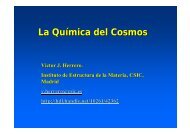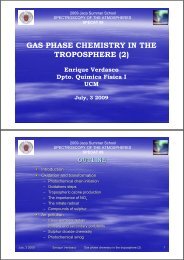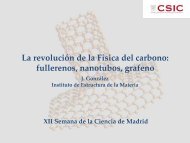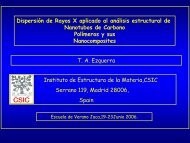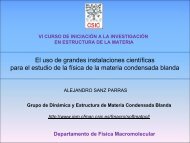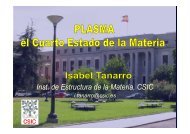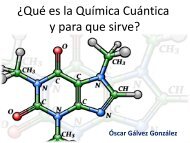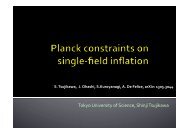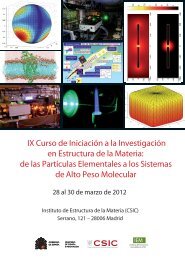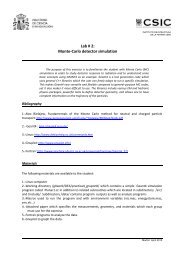done in col<strong>la</strong>boration with researchers of the University P. J. Safarik of Kosice (Slovak Republic) and withresearchers of the University of Hokkaido from Sapporo (Japan).INTERACTION BETWEEN METAL NANOPARTICLES AND BIOMOLECULESMethods for the functionalization of NPs with biomolecules to confer greater biocompatibility were also testedduring the <strong>la</strong>st year. In this sense, we conducted a study of the adsorption of pepti<strong>de</strong>s of varying sequence anddifferent po<strong>la</strong>rity and hydrophobicity to evaluate their affinity for metal surfaces. In particu<strong>la</strong>r, our attention wasfocused on studying the adsorption of cysteine and cystine, two amino acids with thiol groups and disulfi<strong>de</strong> bonds,whose stability has been studied in the presence of Ag and Au. This work was carried out in col<strong>la</strong>boration withresearchers from the University of Paris XIII.Re<strong>la</strong>ted to the <strong>la</strong>tter research we have also conducted the study of the adsorption on metals of high biologicalsignificance proteins such as human and bovine albumin and myoglobin, an important protein re<strong>la</strong>ted to the oxygentransport and storage in muscles. Methods have been tried to increase the affinity of pepti<strong>de</strong>s and proteins by metalsurfaces employed in SERS, namely we have accomplished the functionalization of NPs with polysacchari<strong>de</strong>compounds having a high affinity for metals, such as chitosan and alginate. This work has been done incol<strong>la</strong>boration with researchers from the University of Chile and the University of Florence.The <strong>la</strong>st year, we continued the research <strong>de</strong>aling with the structural analysis of biological materials difficult tocharacterize by conventional spectroscopic techniques. In this area we have carried out a study of the adsorption onmetallic NPs of humic substances and me<strong>la</strong>nins, which result from the digestion processes induced by fungi. Inparticu<strong>la</strong>r, we have conducted a SERS / SEF study on humic substances of different origins (soil, leonardite, lignite)on both Ag NPs as on metal electro<strong>de</strong>s, in or<strong>de</strong>r to study the effect of the applied potential on the SERS spectra andSEF of these substances. Finally, we <strong>de</strong>veloped a study of the structure of the organic matter and charcoal extractedfrom forest <strong>la</strong>nds that have suffered a fire, by using Ag NPs. These studies were performed in col<strong>la</strong>boration withresearchers from the Universities of Bologna and Florence.We have re-initialized a researching line based on the application of metal NPs in the characterization ofanthraquinonic natural substances with potential antitumor properties. In particu<strong>la</strong>r, this study has focused onparietin, a pigment present in lichens of Xanthoria parietina genre. In addition, we have also conducted a study ofthe distribution of pigment in the leaves of these lichens by Raman imaging. This work was done in col<strong>la</strong>borationwith the Department of Biophysics of the University PJ Safarik in Kosice (Slovak Republic),Recently, we have started a new line of work also in col<strong>la</strong>boration with Department of Biophysics, University PJSafarik in Kosice and the Institute of Experimental Physics, Slovak Aca<strong>de</strong>my of Sciences, consisting of the study bySERS and SEF of thiof<strong>la</strong>vin dye SEF and its interaction with amyloid pepti<strong>de</strong>s. The interest of this research resi<strong>de</strong>son the fact that the <strong>la</strong>tter compounds are consi<strong>de</strong>red precursors of the Alzheimer's disease. This study aims atcharacterizing the changes in the structure of the dye in the complex with amyloids, in or<strong>de</strong>r to carry out the<strong>de</strong>tection of small quantities of the dye, which may allow the <strong>de</strong>tection of low amounts of amyloid compound,leading to an early <strong>de</strong>tection of the disease.SURFACE-ENHANCED FLUORESCENCE ON METAL SURFACES (SEF)During this past year we have continued with the technical implementation of the SEF (Surface-enhancedFluorescence) on NPs in colloidal suspension. This method has allowed the study of adsorption and aggregation ofdrugs, especially antitumor drug emodin, and anti-inf<strong>la</strong>mmatory drug piroxicam on metal nanoparticles. It has alsobeen found that the functionalization of metal nanopatícu<strong>la</strong>s SEF is crucial, since the intensification of fluorescencerequires a certain distance of the fluorophore on the metal. The interaction of these drugs with albumin results in aconsequent increase in the SEF spectra, along with the SERS spectra, circu<strong>la</strong>r dichroism spectra and fluorescencelifetime have led to important results on the structural changes un<strong>de</strong>rgone by these systems once adsorbed on themetal surface. In particu<strong>la</strong>r, we have studied thefluorescence quenching that the drugun<strong>de</strong>rgoesin the complexwithalbumin andin the presence ofAgNPs, and the different contributions to this quenching from the so-calledstaticand dynamic quenching mechanisms.Besi<strong>de</strong>s, as a part of MICROSERS project supported by Comunidad <strong>de</strong> Madrid, a new col<strong>la</strong>boration with UAM hasbeen established in or<strong>de</strong>r to <strong>de</strong>sign new systems for controlled release of drugs. These systems are based on poroussilicon. The preliminary results obtained have been satisfactories since we could <strong>de</strong>tect the antitumoral agent emodinby SEF using this method of infiltration.This line ofinvestigation is being conductedby Prof.Mª PazSevil<strong>la</strong>.62
NANOSENSORS BASED ON SERS FOR DETECTION OF DRUGS USED IN SPORT DOPINGWe have ma<strong>de</strong> significant progress in the research involving the application of SERS technique for <strong>de</strong>tection andcharacterization of drugs used in sport doping (DSD). This research was the basis of the PhD work of IreneIzquierdo. During <strong>2011</strong> significant results have been published regarding the SERS study of β-agonists clenbuterol,salbutamol and terbutaline, and aminoglutethimi<strong>de</strong>, an aromatase inhibitor used in athletes to avoid muscle loss. Theuse of Ag NPs shaped triangu<strong>la</strong>r prisms lead to much lower <strong>de</strong>tection limits of these compounds to levels not<strong>de</strong>tected by conventional techniques up to now. In this regard, a comparative study of the efficacy of NPs withdifferent nature and morphology was performed. Also, since the SERS <strong>de</strong>tection of DSDs can be done univocally bySERS spectra, which represents actual fingerprints of these compounds, a multicomponent analysis or mixtures ofthese doping agents is also possible. Furthermore, this study was also carried out together with a theoretical study ofthe vibrational mo<strong>de</strong>s of the doping agents. In addition, from the adsorption isotherms of the investigated drugs onmetal NPs, it was possible to obtain important structural parameters of these molecules, such as the adsorptionconstant on the nanostructures employed, the <strong>de</strong>tection limit, the SERS enhancement factor and the maximum SERSsignal. Likewise, it was successfully finished the SERS study of some doping drugs of difficult study, such asnandrolone, thanks to the synthesis of a cyclo<strong>de</strong>xtrin with enhanced affinity towards the surface of Ag by<strong>de</strong>rivatization with DTC. The spectra analysis has allowed important structural information about the mechanisms ofinteraction between the DSD and host linked on the surface. This research finally gave rise to a patent that iscurrently un<strong>de</strong>r consi<strong>de</strong>ration by the Technology Transfer Office of CSIC.LASER TECHNIQUES APPLIED TO THE STUDY AND CONSERVATION AND RESTORATION OFWORKS OF ART AND MONUMENTSWithin this line of research it was completed the work involving the application of SERS and SEF spectroscopy tothe study of synthetic high performance organic pigments carried out by the PhD stu<strong>de</strong>nt Elena <strong>de</strong>l Puerto. Thepigments studied in this work were several quinacridone <strong>de</strong>rivatives, known for their durability, partly due to itshigh insolubility in aqueous media, what makes very difficult to address their characterization by spectroscopictechniques. To accomplish this, we have firstly <strong>de</strong>termined the optimal conditions for carrying out the dispersion ofthese molecules. This was done by using as dispersant agents functionalized calixarenes with different sizes (from 4to 8 benzene rings), finding a good corre<strong>la</strong>tion between the cavity of the host molecule and the size of the pigment.The adsorption of these molecules on metals by Langmuir-Blodgett films also allowed their characterization, as wel<strong>la</strong>s their study by SERS and SEF as a function of the distance of the pigment with respect to the surface. During thisyear we have completed the study of two new <strong>de</strong>rivative quinacridone pigments with a great interest in the<strong>de</strong>velopment of OLED (Organic Light Emission Dio<strong>de</strong>s), which began to be characterized the previous year. These<strong>de</strong>rivatives were dichloroquinacridone and dimethylquinacridone, whose characterization has been carried out by thespectra corresponding SERS and SEF. In some cases it was necessary the use of other dispersing agents such asalkylic and imidazolic ionic liquids, as well as ,-alkyldiamines, to obtain acceptable SERS spectra.Raman spectroscopy and SERS techniques have also been applied in the study of pigments contained in ancientMoroccan Is<strong>la</strong>mic manuscripts. In this regard, the application of the SERS technique has been useful in i<strong>de</strong>ntifyingthe red and yellow pigments of organic nature, which can not be characterized by conventional techniques due to thehigh emission of fluorescence of these dyes. SERS spectra obtained from pink red inks of the <strong>la</strong>tter colors revealedthe presence of carmine red, which are also present in b<strong>la</strong>ck inks with reddish hues. This work was ma<strong>de</strong> possible bya bi<strong>la</strong>teral col<strong>la</strong>boration with researchers CNRST CSIC-University Mou<strong>la</strong>y Ismail of Meknes in Morocco.The SERS technique has been used in the characterization of dark-colored residual substances found in the cave ofLascaux (France). These substances are produced by the combined action of microorganisms on the paint that are inthe walls of this cavern. The SERS technique has allowed the i<strong>de</strong>ntification of these compounds, due to attenuationof the fluorescence, leading to the structure of these materials, so that the origins of such <strong>de</strong>gradation can beun<strong>de</strong>rstood. This project was conducted in col<strong>la</strong>boration with Prof. C. Saiz-Jimenez of IRNAS (CSIC).During the <strong>la</strong>tter year we continued with the application of Raman spectroscopy in the characterization of molecu<strong>la</strong>rorganic additives traditional and commercial. While traditional additives (egg, sugar, etc.) have a known structure,the structures of the commercial additives are very complex, being a mixture of several compounds and thereforedifficult to interpret. The modification of the hydration process of traditional bin<strong>de</strong>rs with different additives hasbeen studied by Raman spectroscopy, analyzing the different polymorphic forms of CaCO 3 resulting from thepresence of the additive. With respect to commercial additives we are still working on obtaining the SERS spectra ofthese for their i<strong>de</strong>ntification in har<strong>de</strong>ned materials. The recovery of waste water treatment p<strong>la</strong>nts and paper industryas a feedstock for the production of new materials is done in col<strong>la</strong>boration with the Department of Synthesis,Characterization and <strong>Materia</strong>ls Recycling IETcc. In the case of using paper pulp, new types of hydrotalcitescrystalline phases have been i<strong>de</strong>ntified by Raman spectroscopy.63
- Page 3:
INTRODUCCIÓNEl Instituto de Estruc
- Page 10 and 11:
Dra. Maria Esperanza Cagiao Escohot
- Page 12 and 13: TALLER ÓPTICOD. José Lasvignes Pa
- Page 14 and 15: 2A.1 DPTO. DEQUÍMICA YFÍSICA TEÓ
- Page 16: empezar a caer. Este fenómeno se e
- Page 19 and 20: Existen varias diferencias entre la
- Page 21 and 22: Estudio de las propiedades estructu
- Page 23 and 24: poblar los estados de interés en 1
- Page 25 and 26: Si bien la técnica TF está bien e
- Page 27 and 28: que no se produzca la ruptura de en
- Page 30 and 31: antitumoral emodina mediante el efe
- Page 32 and 33: Esta formulación ha sido desarroll
- Page 34 and 35: oooooCriogenia.Espectroscopía Rama
- Page 36 and 37: FLUIDODINÁMICA MOLECULAREl princip
- Page 38 and 39: También se ha concluido y publicad
- Page 40 and 41: o Análisis mecánico en tracción:
- Page 42 and 43: cuerpo (BCC), tiene lugar la formac
- Page 44 and 45: BIOSAXSCaracterización de coloides
- Page 46 and 47: Sin embargo, desde el punto de vist
- Page 48 and 49: 2B.1 THEORETICAL PHYSICS AND CHEMIS
- Page 50 and 51: terms and that b) stellar pulsation
- Page 52 and 53: We have investigated transport thro
- Page 54 and 55: een proposed as possible interstell
- Page 56 and 57: The figure shows a compilation of t
- Page 58 and 59: oppositely aligned spins. This pair
- Page 60 and 61: PHYSICAL BEHAVIOR AT NANO-SCALESPro
- Page 64 and 65: Finally, we have also conducted a w
- Page 66 and 67: species have been obtained from tim
- Page 68 and 69: Rideal mechanism, with a preference
- Page 70 and 71: Liquid hydrogen filament (5 micron
- Page 72 and 73: Nanostructure of polymer thin films
- Page 74 and 75: morphological model for Natural Rub
- Page 76 and 77: product. The clay can be used direc
- Page 78 and 79: with the extracellular ERBBs domain
- Page 80 and 81: 3.1 DPTO. DEQUÍMICA YFÍSICA TEÓR
- Page 82 and 83: Duration: January 2010-December 201
- Page 84 and 85: Objectives: This Project aims at ob
- Page 86 and 87: Funding Institution: Comunidad de M
- Page 89 and 90: CAPÍTULO 4COOPERACIÓN CIENTÍFICA
- Page 91 and 92: 4.1.3 DPTO. DE FÍSICA MOLECULAR /
- Page 93 and 94: o Complete Hybrid Quantization of a
- Page 95 and 96: R3B Collaboration Meeting, Darmstad
- Page 97 and 98: SERS Roundtable 2011, Poltersdorf (
- Page 99 and 100: International Conference on Process
- Page 101 and 102: 4.3. ESTANCIAS DE INVESTIGADORES EN
- Page 103 and 104: Dr. Francesca Vidotto.Université d
- Page 105 and 106: 4.4.3 DPTO. DE FÍSICA MOLECULAR /
- Page 107: Guillermo Ribeiro Jiménez. Subatom
- Page 110 and 111: 5.1 DOCENCIA / TEACHING5.1.1 DPTO.
- Page 112 and 113:
5.1.3 DPTO. DE FÍSICA MOLECULAR /
- Page 114 and 115:
5.2.3 DPTO. DE FÍSICA MOLECULAR /
- Page 116 and 117:
Óscar Gálvezo Hielos y Plasmas de
- Page 118 and 119:
Olof Tengblad- Deputy Technical Man
- Page 120 and 121:
5.5 ACTIVIDADES Y MATERIAL DE DIVUL
- Page 122 and 123:
Plasma, el cuarto estado de la mate
- Page 124 and 125:
5.7 UNIDADES ASOCIADAS Y OTRAS ACTI
- Page 126 and 127:
oScientific collaboration on “Din
- Page 128 and 129:
6.1 PUBLICACIONES EN REVISTAS Y PRO
- Page 130 and 131:
Prescriptions in Loop Quantum Cosmo
- Page 132 and 133:
Richardson-Gaudin Models: The Hyper
- Page 134 and 135:
79. L. Guerrini, S. Sanchez-Cortes,
- Page 136 and 137:
Probing the Nature of Particle-Core
- Page 138 and 139:
PROCEEDINGS ISI /ISI PROCEEDINGS120
- Page 140 and 141:
Physical Review Letters 106, 245301
- Page 142 and 143:
Conducting Nanocomposites Based on
- Page 144 and 145:
3. O. S. Kirsebom, S. Hyldegaard, M
- Page 146 and 147:
6.4 TESIS DOCTORALES / Ph. D. THESE
- Page 149 and 150:
CAPÍTULO 7TABLAS Y DATOSCHAPTER 7T
- Page 151 and 152:
Spectrochimica Acta B 2 3.552Chemph
- Page 153 and 154:
7.4 PERSONAL POR DEPARTAMENTOS /PER
- Page 155 and 156:
ÍNDICEINDEX155
- Page 157 and 158:
4.1.2 Dpto. de Espectroscopía Nucl
- Page 159:
6.2.2 Dpto. de Espectroscopía Nucl




